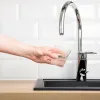Leaky sinks are no fun at all. “Why is my sink leaking underneath,” you ask? Well, there are several different potential causes!
It also depends on whether we’re talking about a kitchen sink or a bathroom sink.
Look, a leaking sink can cause lots of problems. If you store things under your sink (and who doesn’t?), a leak can ruin all of them. It can also lead to mold problems, rotten cabinet wood, and crazy-high water bills. You want to stop the leak as soon as possible!
Let’s take a look at why sinks leak from underneath and what’s to be done about it. We’ll consider issues specific to kitchen sinks and bathroom sinks.
Why is my kitchen sink leaking underneath?
You need your kitchen sink. Not only that, you need it to not leak all over your garbage bags, dishwasher pods, and cleaning products.
Kitchen sinks leak from underneath for a variety of reasons. Maybe you need drain cleaning. Or maybe you just need to replace some parts. Here are the most common causes:
Big clogs
Clogged pipes can cause links under your kitchen sink. For example, you might notice a leak beneath the drain or around the P-trap. If you see leaks in these places, it doesn’t for sure mean you have a nasty clog.
But there’s a good chance you do.
When your kitchen sink is clogged on both sides or even just one side, your best course of action depends on how serious the clog is. If it’s just some gunk that’s built up over time, a sink plunger might do the trick.
However, things get tricky when the clog consists of large food chunks that probably should have been tossed in the trash. For that, you may need a plumber’s snake… or an actual plumber. Did we mention your sink might smell bad?
Corroded or damaged parts
If you’ve got a leak at the P-trap and your P-trap is made of metal, look for corrosion. Older P-traps will corrode over time and start leaking. If this is your problem, you will need to replace the P-trap.
Got a leak at the water supply? This can be pretty serious. It might even be spewing into your cabinets! First, cut off the water supply if you haven’t already done so. Then look at your supply hose and check for a failed gasket. These gaskets can corrode over time and cause a major leak.
Cracked plumber’s putty at the sink flange can also lead to leaks underneath the sink. You will need to remove the drain body and the flange, re-putty the flange, and reinstall it. If you’re not comfortable doing that kind of work, a plumber can help.
Garbage disposal issues
Most people love their garbage disposals. However, a disposal is just a machine. And machines contain parts that break or get damaged.
Sometimes, the damage to those parts leads to a kitchen sink leaking underneath.
Really old garbage disposals might develop cracks in the housing. When this happens, you’ll just have to replace it. Old units are also susceptible to corrosion, especially on the metal parts at the bottom of the disposal. This, too, can cause the disposal to leak.
Occasionally, garbage disposals leak because a few connections need to be tightened or because there was an installation error. Reinstall the garbage disposal according to the manufacturer’s instructions to address the issue.
Why is my bathroom sink leaking underneath?
When your bathroom sink leaks into the cabinet below, you can kiss your clean toilet paper and boxes of band-aids goodbye. It’s a real pain!
Much like kitchen sinks, bathroom sink leaks can be caused by various things. Some of them are specific to bathroom sinks because of the way those sinks are designed. These are the causes we see most often:
Cracked plumber’s putty
Yep! Cracked putty at the sink flange can affect bathroom sinks, too. As with a kitchen sink, the drain body will need to be removed so you can apply new putty beneath the flange and reinstall it.
If you see water coming out right around the sink drain, this might be your problem. However…
Bad washers or gaskets
These can also cause a leak just beneath the drain. You will need to remove the retaining nut and check the washer that lives there. Is it corroded? Replace it with one that’s the correct size and reinstall the retaining nut.
Since this is a bathroom sink, you will need to remove the pivot rod from the drain as you check on the washer beneath the retaining nut.
There are also washers at the P-trap. If that’s where your leak is, you will need to remove the trap itself and replace the slip nuts and washers.
Corroded tailpiece
If this is why your sink is leaking underneath, you’ll have to replace the tailpiece… or have a plumber do it.
Sometimes, old tailpieces are hard to remove. If the tailpiece is old and brittle, you might accidentally crush it in the process of removing it. Use needle-nose pliers to be sure you’ve gotten all of the tailpiece fragments out from beneath the sink. Be sure to replace the P-trap’s slip nut and washer when you replace the tailpiece.
Now you know why your sink is leaking underneath
Parts corrode. They break. Stuff gets kicked around and damaged. It happens to all of us!
By now, you probably know why your sink is leaking and what you should do about it. If you’re still not sure why your sink leaks underneath or need some help fixing the problem, PV can help! We serve the entire Metro Atlanta area and can address any plumbing problem you’ve got.
Give us a call at (404) 994-2229 today or fill out the form below!






